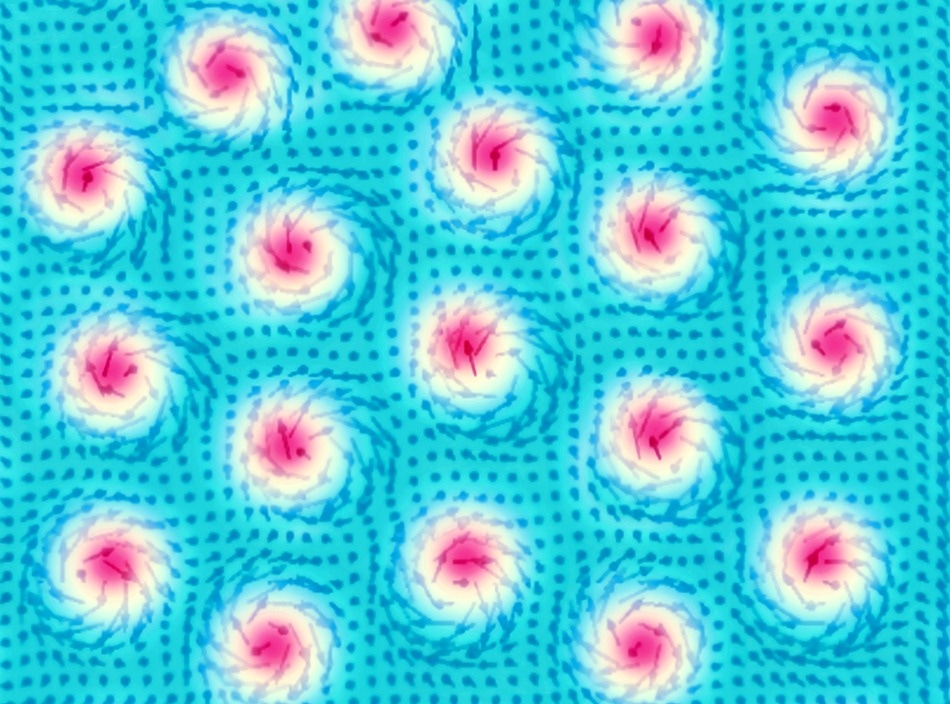Oct 16 2019
The small magnetic vortices called skyrmions that form in certain magnetic materials, like Cu2OSeO3, can be controlled by applying low-level electrical currents, promoting more energy-efficient data processing.
 The illustration demonstrates skyrmions in one of their Eigen modes (clockwise). (Image credit: © Yotta Kippe/HZB)
The illustration demonstrates skyrmions in one of their Eigen modes (clockwise). (Image credit: © Yotta Kippe/HZB)
Currently, researchers at the VEKMAG station of BESSY II have been able to develop a new method for accurately measuring these vortices and identifying their three different expected characteristic oscillation modes (eigen modes).
Cu2OSeO3 has interesting magnetic properties. Magnetic spin vortices called skyrmions are produced within a specific temperature range in the presence of a small external magnetic field.
At present, although relatively low temperatures of about 60 K (−213 °C) are necessary for their phase stabilization, there is a possibility to shift this temperature range to ambient temperature. An interesting feature is that it is very easy to set skyrmions in motion and control them, thereby providing new ways to minimize the energy needed for data processing.
Three Different Eigen Modes Expected
Theoretical study had shown that using a high-frequency electric field, a class of skyrmions in the sample could be excited such that their cores can rotate fully, synchronously like a fish swarm, counter-clockwise or clockwise, or instead can even show a “breathing” motion.
For the first time, researchers have used a single-crystal Cu2OSeO3 sample and successfully measured the dynamics of these skyrmions.
Conventional laboratory methods like ferromagnetic resonance, cannot detect directly deflection of the spins in the skyrmion phase and are therefore not suitable for observing selectively their excitations. Therefore, we had to come up with something new.
Prof. Christian Back, Technical University of Munich
First Experimental Observation at VEKMAG
BESSY II researchers were successful in coupling a spin-resolving technique with an external microwave field.
The resonant magnetic scattering technique when combined with magnetic vectorial external fields shows where the spins are located in the lattice and how they are oriented in space, and all these for each elemental spin species that may exist in the specimen.
Dr Florin Radu, Physicist, Helmholtz-Zentrum Berlin
Radu developed and launched the VEKMAG end station in collaboration with colleagues from the Ruhr University Bochum, Universität Regensburg, and Freie Universität Berlin. The German Federal Ministry of Education and Research (BMBF) and HZB supported the construction and enduring development of the VEKMAG station.
The researchers used electric field-induced ferromagnetic resonance excitation and measured x-ray intensity of a so-called Bragg peak to show experimentally for the first time the existence of all three characteristic oscillation modes in Cu2OSeO3. They found magnetic skyrmions rotating counterclockwise, clockwise, and stretching and contracting (“breathing” mode).
These modes can be changed and deviated by changing the microwave field frequency. Each of these dynamic modes can be realized for a particular frequency, depending more on the external magnetic field and other intrinsic parameters of the sample. According to Radu, “This is a first step towards phase specific characterization of controlled skyrmion’s gyrational motion.”